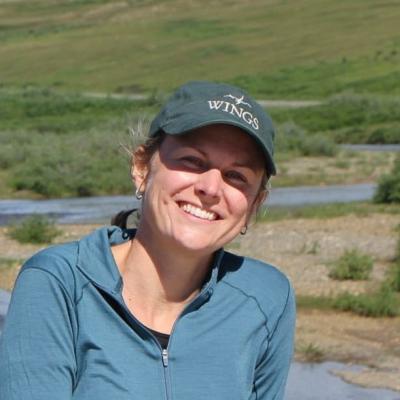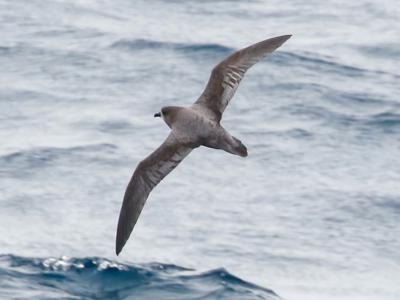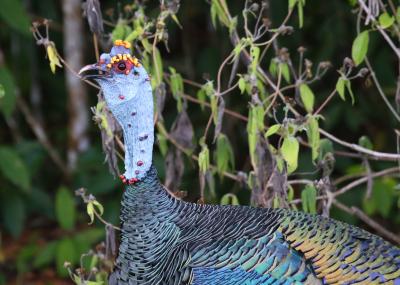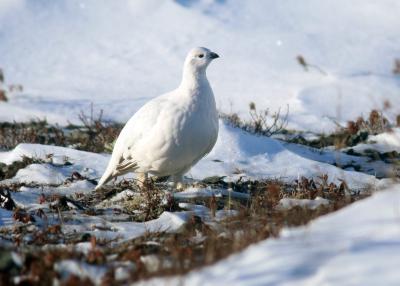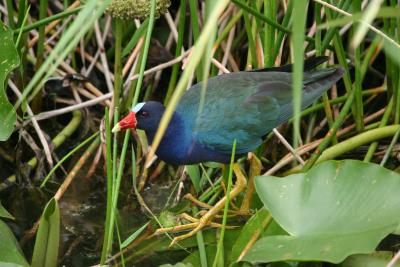New Jersey: Cape May
-
Sep 27 to Oct 3 2025
Skye Haas
There’s no other way to put it: Cape May is the place to watch the fall migration in eastern North America. At regular intervals, the weather both induces birds to migrate and drives them to the coast, where geography funnels them to the very tip of this narrow sandy peninsula, often followed by impressive numbers of Peregrine Falcons, Merlins, and Sharp-shinned Hawks. Cape May’s marshes, beaches, and mudflats attract sometimes dazzling numbers of egrets and shorebirds, while gulls, terns, and the occasional jaeger or pelican patrol the nearshore waters of the Atlantic.
Apart from our first night in Philadelphia, we’ll be based in a single hotel in Cape May, letting us keep our day-to-day schedule as flexible as possible so that we can take advantage of changing weather conditions—and the unexpected rarities that can show up at any time.
Day 1: The tour begins at 6:00 pm in our Philadelphia airport-area hotel, followed by dinner. Night in Philadelphia.
Cape May with Skye Haas was a great tour. Skye had served for several years at the sea watch, and built up good relationships with the excellent local birders. This really benefited our tour, because he was able to network to find the very best birds and locations each day. Skye is a very pleasant person, good leader, and fantastic birder. He is also a patient and enthusiastic teacher, bringing everyone’s birding up a level. Over 150 species were seen, with care that each member of the group saw every bird. We were also fortunate to hit peak migration and great weather. The warblers and other migrants literally landed all around us in early mornings, and the hawk watch was astonishing. Lastly, the hotel and top restaurants were a pleasure. Thanks for a wonderful time! I highly recommend this tour. - Judi W
Day 2: We’ll leave Philadelphia after an early breakfast for the two-hour drive to Cape May. If the weather seems good for a passerine flight, we’ll drive straight through; otherwise, we’ll make a few stops along the Delaware Bayshore to look for migrants. Once in Cape May, we’ll walk the trails through the weedy fields of Higbee Beach and Hidden Valley to see what may have dropped in overnight. We’ll spend the afternoon at Cape May Point State Park, walking the beach for gulls and terns, checking the ponds for shorebirds—and constantly, obsessively looking up: Bald Eagles are frequent fly-bys this time of year, and up to a dozen species of raptor can occur in numbers. Night in Cape May.
Day 3-4: Even more than the rest of Cape May, Higbee Beach at dawn is charged with all the mystery and excitement of migration. As the sun rises over the ocean, and assuming there has been a good nocturnal migration, the morning flight of Northern Flickers, vireos, warblers, Scarlet Tanagers, and Bobolinks peaks as birds continuing on from night migration encounter the barrier of the Delaware Bay and swing north right over Higbee Beach. The most numerous warblers are likely to be Northern Parula, Black-and-white, and American Redstart, but on a good flight day, more than 20 species are possible, including such uncommon birds as the Connecticut Warbler. Later risers than the falcons and accipiters, Black and Turkey Vultures also spend the night in the area, their lumpy dark forms simultaneously eerie and comical as they crowd the trees.
Each morning will be slightly different and there’s always something new. From Higbee, we’ll drive just down the road to The Nature Conservancy’s South Cape May Meadows. The freshwater ponds and marsh here, protected from the ocean by high dunes, are a great place to watch roosting waterfowl, shorebirds, and terns at close range. We may also bird Cape May Point State Park with its iconic hawk watch platform, an excellent viewpoint to see pond, ocean and sky. In the afternoon we’ll drive north along the Atlantic coast to Stone Harbor, a long barrier island that serves as a regular hang-out for American Oystercatchers, Piping Plovers, Black Skimmers, and roosting terns including Caspian, Common, Forster’s and Royal. The nearby saltmarsh of Nummy Island is famous for the Tricolored and Little Blue Herons that feed daintily in the grassy salt pans. Night in Cape May.
Day 5: We’ll let last night’s weather determine our pre-dawn destination, whether it’s back to Higbee Beach or the Meadows or through the well-treed neighborhoods around the Point. After breakfast, we’ll make the hour’s drive north to the Brigantine unit of Forsythe National Wildlife Refuge. Brig is the best place around to look for godwits, and we should find White-rumped and Western Sandpipers among the thousands of Semipalmated Sandpipers. American Golden-Plover is also a possibility here—as is just about any shorebird ever recorded in eastern North America. Boat-tailed Grackle can be common, and any of the marsh-specialist sparrows is possible along the eight-mile wildlife drive. Night in Cape May.
Day 6: This morning we’ll follow the birds across the mouth of Delaware Bay, taking a large, stable car ferry seventeen miles from Cape May to Lewes, Delaware. Along the way we’ll be on the lookout for Brown Pelicans, Northern Gannets, and Parasitic Jaegers, which regularly harass the flocks of Common and Forster’s Terns feeding offshore. Once in Delaware, we’ll bird Cape Henlopen State Park for Brown-headed Nuthatches and migrants, then move north to Prime Hook National Wildlife Refuge for shorebirds. We’ll have a late lunch, then board the ferry for the return trip to Cape May. Night in Cape May.
Day 7: After a final early morning in Cape May, we’ll return to Philadelphia International Airport where about noon the tour concludes.
Note: The information presented here is an abbreviated version of our formal General Information for Tours to New Jersey. Its purpose is solely to give readers a sense of what might be involved if they take this tour. Although we do our best to make sure that what follows here is completely accurate, it should not be used as a replacement for the formal document which will be sent to all tour registrants, and whose contents supersedes any information contained here.
ENTERING THE UNITED STATES: Non-US citizens will need a valid passport and may need a tourist visa. Consult your nearest US Embassy or consulate for details. All participants must carry some form of photo ID for boarding the Cape May - Lewes ferry.
HEALTH: Birdwatching in New Jersey and Delaware poses no major health hazards. Though their numbers will have decreased greatly by late September, mosquitoes are likely in the more sheltered wooded areas, and biting flies may be present in the saltmarshes. Ticks in this area are known to carry Lyme disease and other potentially serious diseases; precautions are in order.
PACE OF THE TOUR: Early mornings in search of dawn migrants should be expected every day, but some morning starts may be later, depending on overnight weather. Birding will typically end before dark, though we may devote a windless evening to owling. We’ll probably be walking a total of a few miles every day, but always at a slow pace, and the terrain is entirely level.
CLIMATE: Fall weather in southern New Jersey and Delaware is usually pleasant, with mornings in the 50s or 60s F and daytime temperatures rarely higher than the 70s. Breezy, partly cloudy weather is the norm. Those very sensitive to the sun should be prepared with the appropriate hat and effective sunscreen. Rain and wind are possible, so raingear is highly recommended.
ACCOMMODATION: Standard motels throughout.
DRESS: Informal throughout.
TRANSPORT: Travel will be in a fifteen-passenger window van driven by the leader.
SMOKING: We request that you not smoke in vehicles or when the group is gathered for meals, checklist sessions, etc. If you are sharing a room with a non-smoker, please do not smoke in the room.
GENERAL INFORMATION AND CONDITIONS OF WINGS TOURS: Please take a moment to read the General Information and Conditions. This section contains important information about how we conduct tours, e.g., what is included in the tour price, refund and cancellation policies, pace of the tours, and other information that will help you prepare for the tour. If you don’t have access to the WINGS website, please ask the WINGS office to send you a copy.
ADDITIONAL INFORMATION: A more complete General Information for Tours to New Jersey and Delaware will be sent to each registrant on receipt of booking. Final information with instructions for meeting the group, hotel addresses, etc., will be mailed about three weeks before trip departure. Other news will be communicated as necessary. If you have any questions, please let us know.
2023 Narrative
I must admit, I was nervous about this tour; showing up in the aftermath of Tropical Storm Idalia was not the most ideal of conditions for a migration tour. The forecast was a never-ending week of east winds, peppered with rain. But I should have remembered, there is ALWAYS something amazing to look at in Cape May! And boy did we start off with a bang too! I don’t quite share some birders’ love of storm birding, as more often than not, it just leaves you wet and birdless, but from time-to-time storms do drop in some great birds. With the day-long rain, I felt a better use of our time would be to bird the extensive wildlife drive at Forysthe National Wildlife Refuge. This place never disappoints, but today with the storm, I was particularly impressed with the fallout of shorebirds – lots of yellowlegs and dowitchers, but unprecedented numbers of Pectoral Sandpipers. As always, there were lots of egrets, Forster’s Terns, and lots of dabbling ducks present. We played hide-and-seek with some Clapper Rails, but a pair of Seaside Sparrows gave great looks for all! Another storm waif was a Black Tern that flew right over the van; normally these birds are way out on the ocean during migration, quite the change in scene from their summer haunts of farmland marshes in the Midwest!
We left the refuge after hours of successful birding; I think everyone was a little dazed that it was only the first day and we had already seen so much. We went and checked into our hotel in Cape May and off to an early dinner. This was a great plan on two accounts, one, we had skipped lunch due to a late breakfast, and two, it allowed for some after-dinner birding. This is where Cape May really rolled out the welcome mat for us…as we were dining, a Brown Booby had flown in not too far from our restaurant to start roosting with some cormorants! We finished up our dinner and drove over to the beach where the booby was quite content to sit and let us soak it in and enjoy it! What a great opening day for a tour!
For our second day at Cape May, we stuck pretty close to the ranch. Unfortunately, there just were no favorable winds to bring migrants to Cape May. Now that being said, we were treated to a couple Prairie Warblers, a local breeding species that normally migrates out of the Cape May area by the time the tour runs. Another special get was a Mourning Warbler, a bird that not only was a new first-ever for this tour, but my first-ever for New Jersey! Another surprise: some Purple Martins, which like the Prairie Warblers are often long gone by this time of year. A fun pair of birds we got this morning were both Red-eyed and White-eyed Vireos. And of course, no trip to Cape May is complete until we’ve had some time with a Cape May Warbler, which of course we did on a few occasions.
The next day, we took our annual boat cruise into the salt marshes of Cape May, always a highlight of this tour! This is a great chance to get up close and personal with the marshes in a flat-bottomed boat with some expert local naturalists who know these waterways well. With the constant east winds, we experienced quite the high tide, subsequently we enjoyed great concentrations of shorebirds, as many of them were forced to spend time in the remaining bits of higher ground in the coastal marshes. We had point-blank looks at American Oystercatchers, Black-bellied Plovers and Ruddy Turnstones, and even were able to get quite the study on tern ID with Common, Royal and Caspian Terns among the plentiful Forster’s Terns. After the boat trip was over, we headed up to a heron rookery where we saw several Yellow-crowned Night-Herons, and stopped by the Wetlands Institute where birds were taking shelter from another wave of the bad weather. Here we had our only Willets of the tour, and our first Tricolored Herons of the trip.
The next morning was surprisingly birdy considering how stormy it was overnight, but the calm and beautiful morning had birds crawling out of their hiding spots. The big flights of scoters that Cape May is renowned for hadn’t really kicked into overdrive yet, but we did have a couple close passes of a few Surf and Black Scoters from the seaside deck where we set up shop for the morning. We had some Bald Eagles passing overhead, and quite a few Palm Warblers hopping in the dunes. Very exciting was when a Blue Grosbeak teed up in a pine tree next to us, allowing for a good look!
For our afternoon, we spent some time on the hawk deck. Again, as with most species of land migrants, east winds aren’t the best for most species of hawks. We did have a trickle of Sharp-shinned and Cooper’s Hawks, but the buteos were conspicuously absent. Ospreys of course were omnipresent, but the one group of raptors we did well on, and they certainly didn’t mind an east wind, were falcons. We had a few American Kestrels and Peregrine Falcons and were treated to an amazing Merlin migration. Merlin after Merlin whipped by, sometimes brushing over our heads, while others made swipes through the huge flock of foraging Tree Swallows, with more success capturing them on the wing than you might expect!
For our penultimate day, we took our big field trip to Delaware. We got up early to board the Cape May-Lewes Ferry. The sail across was decently birdy with pelicans and terns frequently observed and for a couple of us, a Parasitic Jaeger showed well. Once we made landfall in Lewes, we headed to Cape Henlopen State Park to the coastal pine forest. We took a hike, but the woods were a bit on the quiet side. No sooner than we had loaded back up in the van that I heard the familiar squeaky sounds of our quarry, Brown-headed Nuthatches! We rolled out of the car as quick as can be, but thankfully the nuthatches were cooperative and stuck around giving us a good show. Several Pine Warblers were present, as well as a family of Eastern Bluebirds and a surprise final Prairie Warbler and Blue Grosbeak. We then drove up to Bombay Hook National Wildlife Refuge, which, like Forysthe, has a first-rate auto drive. There was a huge flock of Green-winged Teal and Northern Shovelers present, but the real stars of the show were the multitudes of shorebirds. Hundreds of American Avocets delighted us as they foraged in the shallow waters of the marsh. Hundreds of dowitchers and yellowlegs were present, and even more peeps surrounded them – a veritable horde of Semipalmated and Western Sandpipers. There were numerous Stilt and White-rumped Sandpipers among them, and we even were able to spot both Marbled and Hudsonian Godwits. Every so often the flock was buzzed by a Peregrine Falcon, and they would fly at once, making for a fantastic spectacle, wheeling about over the marshes!
So, in retrospect I shouldn’t have doubted – even in predicted bad weather, there are few places that can beat Cape May as a birding hotpot in the Fall! We ended the tour with 142 species of birds and enjoyed some great dining in the charming resort town that is Cape May. Thank you to all the participants who made this such a wonderful trip!
- Skye Haas
Skye is a very pleasant person, good leader, and fantastic birder. He is also a patient and enthusiastic teacher, bringing everyone's birding up a level.
- Judith W. on New Jersey: Cape May
Skye was the best tour leader I could hope to have. I am a beginning birder and we had a variety of knowledge among the tour members. Skye did a superb job of adjusting to our various needs for information, to adjusting as needed to make sure each of us could see the birds, to adjusting on the fly when new info came in about where the birds were, or the best areas to bird at a given moment. His extensive knowledge of so many individual birds and their details: male and female coloring, their songs, their flight patterns, where they should be or not be and he has an excellent ability to convey the info to us.
- Kathy K. on New Jersey: Cape May
Cape May with Skye Haas was a great tour. Skye had served for several years at the sea watch, and built up good relationships with the excellent local birders. This really benefited our tour, because he was able to network to find the very best birds and locations each day. Skye is a very pleasant person, good leader, and fantastic birder. He is also a patient and enthusiastic teacher, bringing everyone’s birding up a level. Over 150 species were seen, with care that each member of the group saw every bird. We were also fortunate to hit peak migration and great weather. The warblers and other migrants literally landed all around us in early mornings, and the hawk watch was astonishing. Lastly, the hotel and top restaurants were a pleasure. Thanks for a wonderful time! I highly recommend this tour.
- Judi W. on New Jersey: Cape May
You all did a great job. Thanks, Erin. Skye was great. Truly a joy to be around. He showed incredible patience, willingness to teach, great improvisation with tougher conditions this year (persistent East Wind), all of which made it a great trip. Thanks, Skye. Hotel was basic but plenty good. Dinner spots were well thought out and excellent. The van was excellent. All in all, a really nice trip made as best as possible despite some slower than normal bird activity.
- Craig D. on New Jersey: Cape May
Maximum group size seven with one leader.







































































































